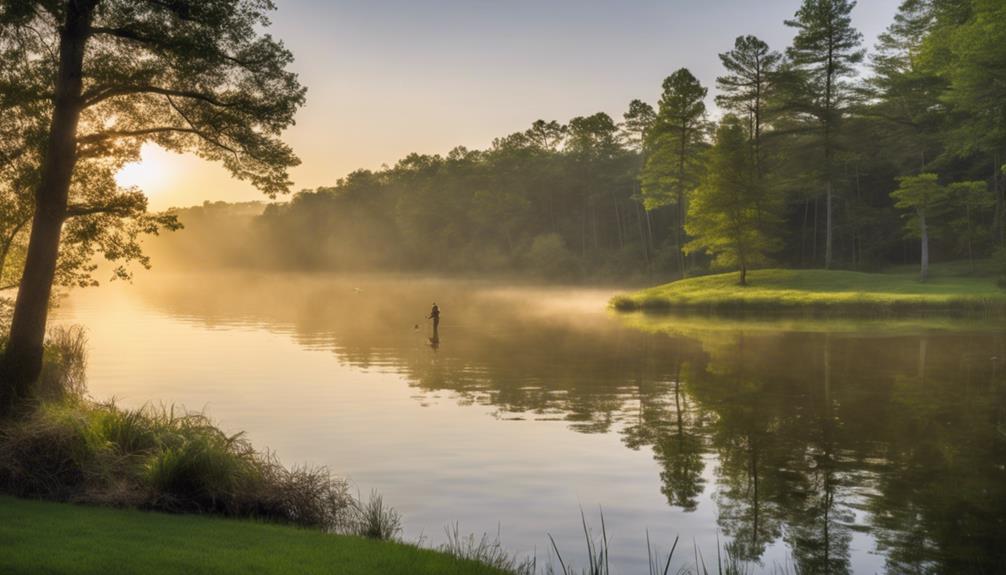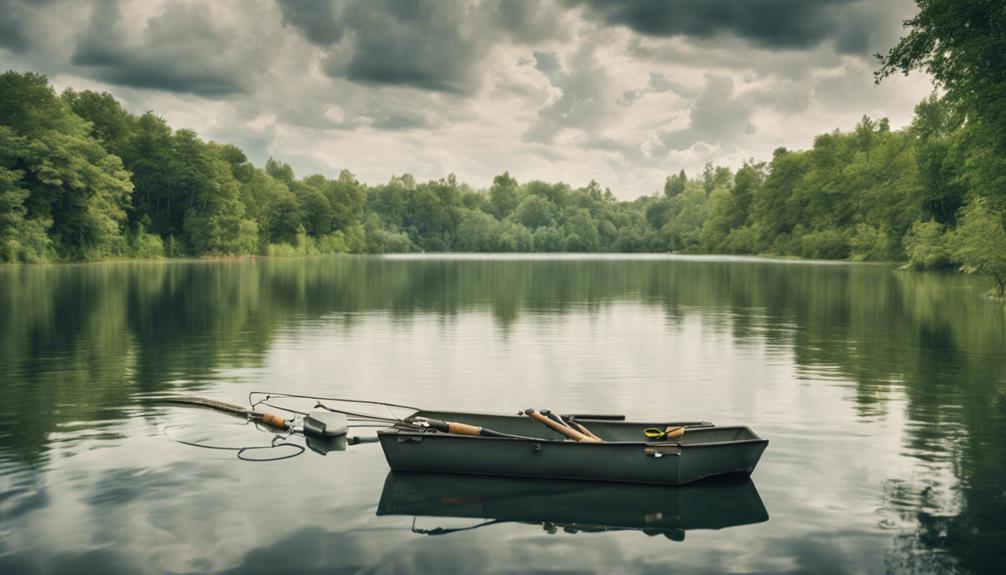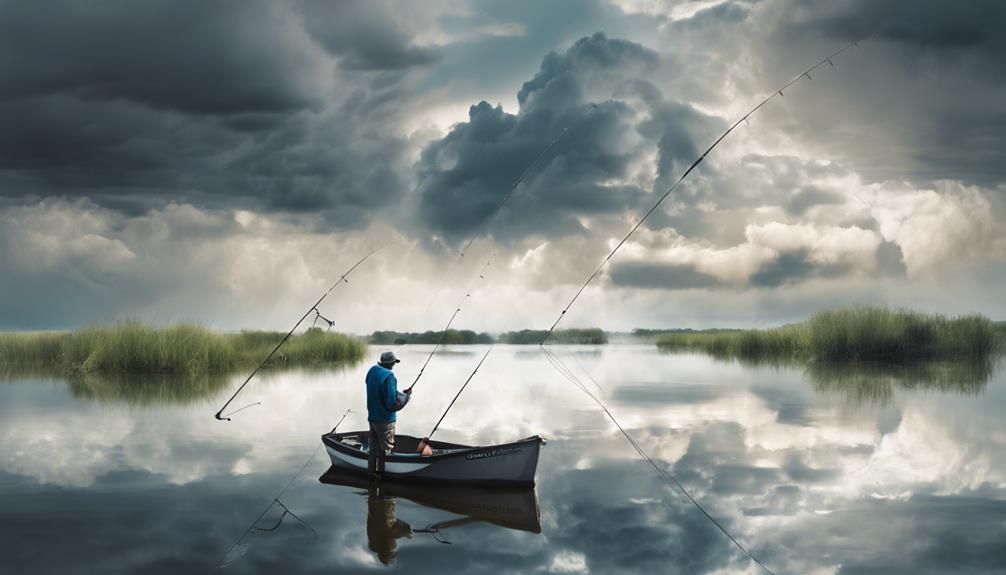Different fish species prefer specific seasons due to environmental factors like water temperature. In winter, fish move to deeper, warmer waters. Spring triggers spawning behaviors influenced by temperature changes. Summer sees increased feeding frenzies due to optimal water temperatures. Fall migration occurs as fish prepare for changing conditions. Weather fluctuations affect fish metabolism and activity. Bass are most active in early morning and late afternoon. Trout thrive in clear, cold waters with ample oxygen. Understanding these seasonal preferences can enhance your fishing success.
Factors Influencing Fish Behavior
Understanding the factors that influence fish behavior is crucial for predicting their movements and habits in different environments. Temperature plays a significant role in shaping fish behavior. Fish are ectothermic, meaning their internal temperature is influenced by external conditions. Temperature directly affects their metabolism, growth rates, and overall activity levels. Variations in temperature can lead to changes in fish distribution as they seek out preferred thermal conditions. For example, some species may migrate to deeper waters during warmer months to find cooler temperatures, while others may move to shallower areas for warmth during colder seasons. These temperature variations are key drivers in determining where fish are located within a body of water.
Habitat preferences also greatly impact fish behavior. Different species exhibit specific habitat preferences based on factors like water depth, substrate type, and vegetation cover. These preferences are often linked to feeding opportunities, protection from predators, and access to suitable spawning grounds. Understanding these habitat preferences can help anglers target specific fish species more effectively. For instance, knowing that a certain species prefers rocky areas with strong currents can guide anglers to suitable fishing spots.
Predation risks and mating rituals are additional factors that influence fish behavior. The fear of predation can alter fish movement patterns, leading them to seek out safer areas with more cover. Mating rituals can also cause shifts in behavior, with fish becoming more active and aggressive during breeding seasons. These behaviors can impact fishing success, as fish may be more or less likely to bite depending on their current activities. By considering these various factors, anglers can better anticipate fish behavior and adjust their strategies accordingly.
Winter Fishing Strategies
Temperature variations and habitat preferences significantly impact fish behavior, leading anglers to adjust their strategies accordingly. During the winter months, fish tend to move to deeper waters to find warmer temperatures and conserve energy. As an angler, understanding winter fishing strategies is crucial for a successful fishing experience.
Here are four essential tips for winter fishing:
- Ice Fishing Techniques: In regions where lakes freeze over, ice fishing becomes a popular method. Anglers drill holes in the ice and use specialized equipment like tip-ups or ice fishing rods to catch fish below the icy surface. Patience is key in ice fishing, as fish are typically less active and feeding sporadically due to the cold water temperatures.
- Use Cold Water Lures: Fish in winter are less active and have slower metabolisms. Therefore, using lures that mimic the movements of dying or injured prey can be effective. Consider using slow-sinking lures or jigs that can be presented at the fish's eye level in cold waters.
- Fish Near Structure: Structure such as rock piles, fallen trees, or underwater ledges can provide shelter and warmth for fish during the winter. Targeting these areas increases your chances of finding fish actively feeding.
- Adjust Your Retrieval Speed: Fish in cold water are less likely to chase fast-moving lures. Slow down your retrieval speed to entice bites from sluggish fish in winter conditions.
Springtime Spawning Patterns
Springtime brings about significant changes in fish behavior as they engage in spawning patterns, a crucial aspect of their reproductive cycle. During this time, various fish species exhibit specific spawning behaviors triggered by environmental cues. These cues often include factors such as increasing daylight hours, water temperature fluctuations, and changes in water chemistry.
Spawning behavior is essential for the continuation of fish populations. It's a carefully orchestrated process where fish release eggs and sperm into the water, allowing for fertilization to occur externally. The timing of spawning is critical, as it ensures that the offspring have the best chance of survival by hatching when environmental conditions are favorable for their development.
Water temperature fluctuations play a vital role in triggering spawning activities. As spring progresses, the gradual increase in water temperature signals to fish that it's time to reproduce. Different fish species have specific temperature thresholds that initiate their spawning behaviors, ensuring that their offspring have the best chance of survival.
Observing fish during their springtime spawning patterns provides valuable insights into their reproductive cycle. By understanding the environmental cues that influence spawning behavior, scientists and anglers alike can better predict when and where certain fish species will spawn, contributing to conservation efforts and sustainable fishing practices.
Summer Feeding Frenzy
During the summer months, fish species in various bodies of water exhibit a heightened feeding frenzy, driven by factors such as increased prey availability and optimal water temperatures. This period of intense feeding activity plays a crucial role in shaping the ecosystem dynamics within aquatic environments.
- Feeding Patterns: The summer feeding frenzy is characterized by frenetic feeding behaviors among fish populations. Predatory species become more active in hunting down prey, leading to a cascade of predator-prey interactions that influence the entire food web.
- Predator-Prey Dynamics: The increased prey availability during the summer months not only sustains predator populations but also influences the distribution and abundance of various fish species. This dynamic interplay between predators and their prey is essential for maintaining ecosystem balance.
- Temperature Influence: Optimal water temperatures during summer enhance metabolic rates in fish, leading to increased energy requirements. As a result, fish need to feed more frequently to meet their energy demands, contributing to the feeding frenzy observed during this season.
- Growth Rates: The abundance of food resources during the summer months can significantly impact the growth rates of fish populations. Fish that have access to plentiful food sources during this period may exhibit accelerated growth, which can have long-term implications for population dynamics and overall ecosystem health.
Fall Migration Routes
As fish populations prepare for the changing environmental conditions, their focus shifts towards navigating the intricate Fall migration routes. During fall migration, fish movement is driven by a combination of factors such as temperature changes, daylight duration, and reproductive instincts. This period marks a crucial time for many fish species as they undertake long journeys to reach their spawning grounds or find suitable feeding grounds to prepare for the upcoming winter months.
Fall migration routes are often well-established pathways that fish follow year after year. These routes are influenced by a variety of environmental cues, including water temperature and current patterns. For example, salmon species are known for their remarkable migration from the ocean to freshwater rivers and streams where they were originally spawned. The timing of fall migration is crucial for fish survival, as they need to reach their destination at the optimal time to ensure successful reproduction or to find abundant food sources.
Observing fish movement during the fall migration can provide valuable insights into population dynamics and ecosystem health. Scientists track these movements using various methods, including acoustic tagging and satellite tracking. Understanding the intricacies of fall migration routes is essential for effective fisheries management and conservation efforts, ensuring the sustainability of fish populations for future generations.
Weather Impact on Fishing
Navigating the intricacies of weather patterns becomes crucial for successful fishing outings, as various weather conditions directly impact fish behavior and overall catch rates.
- Temperature Fluctuations: Fish are ectothermic, meaning their body temperature is influenced by the external environment. Temperature changes can significantly affect their metabolism, which in turn alters their activity levels. For example, in colder water, fish like trout tend to be more sluggish, while warmer temperatures can trigger increased feeding behavior in species such as bass.
- Barometric Pressure Shifts: Meteorological conditions, including changes in barometric pressure, play a vital role in angler success. When a low-pressure system moves in, fish tend to become more active and feed more aggressively. On the other hand, high-pressure systems can result in decreased fish activity, making it more challenging to entice bites. Observing barometric trends can help anglers anticipate fish behavior accordingly.
- Wind Patterns: Wind can create ripples on the water's surface, which can either help or hinder fishing efforts. While moderate winds can oxygenate the water and push baitfish closer to the shore, excessively strong winds can make casting difficult and disrupt the feeding patterns of certain fish species.
- Precipitation Events: Rainfall can have mixed effects on fishing. Light rain can sometimes stimulate fish to feed, as it can wash insects and other food sources into the water. However, heavy rain can muddy the water, disorienting fish and reducing visibility, making them less likely to bite. Understanding how different fish species respond to varying precipitation levels is key to adapting your fishing strategy accordingly.
Best Times for Bass

Understanding the optimal times for bass fishing involves keen observation of environmental cues and fish behavior patterns. Bass are most active during the early morning and late afternoon periods, coinciding with their feeding times. During these times, bass are more likely to respond to bait and lures, making them ideal for anglers looking to maximize their catch.
In the early morning, bass tend to be closer to the surface, making it a great time to use topwater techniques. The low light conditions at dawn stimulate bass to hunt for prey near the water's surface, providing an excellent opportunity for anglers to use lures like buzzbaits or poppers to attract strikes. As the day progresses, bass often move to deeper waters, especially in warmer weather. This shift in behavior makes deep diving lures effective tools for reaching bass in their preferred depths.
Late afternoon presents another prime window for bass fishing. Similar to the early morning, bass become more active as the day starts to cool down. Anglers can capitalize on this by using topwater techniques once again or transitioning to deep diving lures if the bass have moved to deeper areas. By understanding these optimal times and techniques, anglers can increase their chances of a successful bass fishing outing.
Optimal Conditions for Trout
Trout thrive in clear, cold waters with ample oxygen levels, displaying a preference for habitats with rocky bottoms and swift currents. When seeking optimal conditions for trout, consider the following:
- Water Temperature: Trout are cold-water fish and prefer temperatures between 50-60°F (10-15.5°C). Higher temperatures can stress trout and lower their oxygen intake, impacting their feeding habits.
- Oxygen Levels: Adequate oxygen is crucial for trout survival. They require well-oxygenated waters to thrive, especially in areas with high water flow that naturally aerates the water.
- Cover and Structure: Trout seek shelter in rocky habitats, using the structures to hide from predators and ambush their prey. Fallen trees, overhanging vegetation, and boulders provide additional cover for trout.
- Food Availability: Trout are opportunistic feeders, consuming a variety of aquatic insects, small fish, and crustaceans. Optimal trout habitats offer a diverse range of food sources, supporting their growth and reproduction.
Understanding these key factors influencing trout habitat and feeding habits can enhance your fishing experience. By locating areas with suitable water temperature, oxygen levels, cover, and abundant food supply, you increase your chances of encountering thriving trout populations.
Remember to respect the delicate balance of these ecosystems to ensure sustainable enjoyment of trout fishing in the long term.
Frequently Asked Questions
How Do Fish Species Communicate With Each Other During Different Seasons?
During different seasons, fish species communicate using various behavioral patterns and communication signals to navigate their environment and interact with one another. These signals play a crucial role in their reproductive cycles and mating rituals.
Through intricate movements, sounds, and chemical cues, fish can convey information about their intentions, dominance, and readiness to mate. This intricate communication system helps ensure successful breeding and survival of the species.
Are There Any Specific Moon Phases That Affect Fish Behavior?
During lunar cycles, fish behavior is influenced by various moon phases. The gravitational pull of the moon can impact feeding patterns, causing fish to be more active or passive. Full moons often trigger increased feeding activity, while new moons may result in reduced feeding behaviors.
Understanding these lunar influences can be crucial for anglers seeking to optimize their fishing success by targeting specific fish species during the most favorable moon phases.
What Impact Does Water Temperature Have on Fish Feeding Habits?
Water temperature plays a crucial role in fish feeding habits. Temperature fluctuations influence the metabolism and activity levels of fish, impacting their feeding patterns.
Warmer water often leads to increased metabolic rates and higher feeding activity in fish species, while colder temperatures can slow down metabolism, causing some fish to be less active and feed less frequently.
Understanding these temperature-related changes is essential for successful fishing strategies throughout the year.
Do Fish Change Their Preferred Habitats During Seasonal Transitions?
During seasonal transitions, fish often change their preferred habitats due to migration patterns and spawning behavior. These shifts are influenced by factors like water temperature, food availability, and breeding instincts. Fish may move to deeper waters or seek out specific environments to reproduce.
Understanding these habitat changes is crucial for effective fisheries management and conservation efforts. By monitoring fish movements during different seasons, researchers can gain valuable insights into their behavior and ecology.
How Do Environmental Changes Like Pollution Affect Fish Behavior in Each Season?
During different seasons, noise and pollution can have a significant impact on fish behavior. These environmental changes can disrupt migration patterns and alter habitat preferences.
Climate change further complicates the situation, influencing fish movements and breeding habits. Understanding how these factors interact is crucial for conservation efforts and maintaining healthy aquatic ecosystems.
Observing these effects across seasons provides valuable insights into the dynamic relationship between fish and their environment.
Conclusion
In conclusion, understanding the varying behaviors of fish species in different seasons is crucial for successful fishing endeavors.
From winter strategies to springtime spawning patterns to the summer feeding frenzy and fall migration routes, each season offers unique opportunities to catch different types of fish.
Weather conditions play a significant role in fish behavior, and knowing the optimal conditions for specific species can greatly enhance your chances of a successful fishing trip.
Keep these factors in mind to maximize your fishing success year-round.



